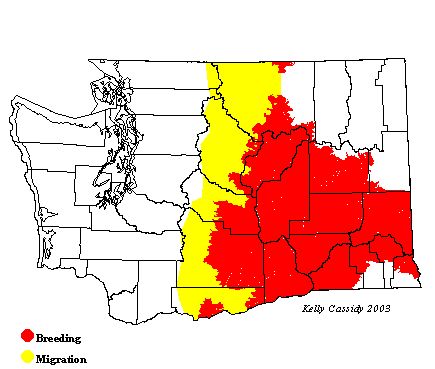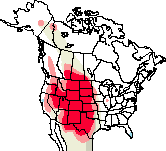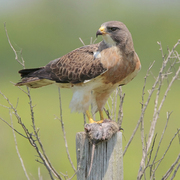Swainson's Hawk
General Description
The Swainson's Hawk is a slender buteo, similar in length to the Red-tailed Hawk, but with a longer wingspan and weighing about 20% less. The pointed wings are held in a strong dihedral in flight. There are three different color phases, light, dark, and intermediate (or rufous), all of which occur in Washington. Pairs are often of mixed color phases. Light-phase adults have a white or mostly white belly, with matching underwings. They have rufous breasts, or bibs, that contrast sharply with their white bellies. The head is dark with white surrounding the bill, extending down to the throat and up to the eyes. The back is solid dark brown. Dark adults are almost solid dark brown with rufous on the belly and underwings. Intermediate plumages fall along a continuum between dark and light phases. All adults have dark flight feathers. Juveniles are generally mottled versions of the adults, with the juvenile of the light phase having a fairly white head at times.
Habitat
Swainson's Hawks forage in open farmland, sagebrush desert, or prairies. Compared to Ferruginous Hawks, Swainson's inhabit moister areas. They nest in wooded groves along streams, windbreaks, or other treed or brushy areas near open habitats, often building nests in introduced locust or cottonwood trees. During migration they are often found in grasslands and harvested fields.
Behavior
During migration, Swainson's Hawks often stop over at recently tilled fields, where insect larvae have been brought to the surface by plowing. In these instances, large flocks can be seen foraging on the ground. They also hunt by soaring over open areas, scanning the ground for prey. They have been known to congregate at the leading edge of a grassfire, waiting for prey to be driven into the open by the oncoming flames.
Diet
During the breeding season, Swainson's Hawks eat many small mammals. In Washington, almost 90% of their diet is made up of ground squirrels. During migration and winter, however, they are almost exclusively insectivorous, with grasshoppers and dragonflies both major components of their diet.
Nesting
Swainson's Hawks nest later than any other raptors in Washington. Courtship begins when they arrive on the breeding grounds. The male Swainson's Hawk makes steep display flights. Both members of the monogamous pair help with nest building, although the male does most of the work. The nest is usually in a tree or shrub from 15-30 feet off the ground, often on top of an old magpie or crow nest, although it can be on a ledge. The nest itself is a platform made of sticks and lined with finer material, often including greenery. The female incubates 2 to 3 eggs for 34 to 35 days. The male brings her food while she is incubating and may take short stints at the nest when she leaves to feed. The female broods the young for about nine days, after which she helps the male provide food. The young birds begin climbing about on tree limbs near the nest at 27 to 33 days, and take their first flights at about 38 to 46 days. Once they begin to fly, the young stay near the nest for 11 to 20 more days.
Migration Status
Swainson's Hawks are long-distance migrants, some traveling more than 6,000 miles each way. They often migrate in large flocks and spend the winter in the native grasslands and agricultural areas of southern Argentina.
Conservation Status
Although they prey on agricultural pests, Swainson's Hawks were formerly presumed to be pests themselves and were killed by farmers and ranchers. With attitudes towards predators changing, this is less of a problem, but habitat destruction and pesticides still pose threats to the Swainson's Hawk population. In the mid-1990s, thousands of Swainson's Hawks were killed on their wintering grounds from direct pesticide spraying, and by eating pesticide-covered grasshoppers. This particular pesticide has since been removed from use. As agricultural practices become more intensive, available habitat shrinks, and there is some evidence that the population is declining in Washington. For these reasons, the Swainson's Hawk is listed on the Audubon watch list for Washington.
When and Where to Find in Washington
Swainson's Hawks are fairly common summer residents in higher grasslands in most of eastern Washington. Most arrive by mid-April and leave in late August or early September. During migration they are sometimes seen in the Cascade Mountains.
 Abundance
Abundance
| Ecoregion | Jan | Feb | Mar | Apr | May | Jun | Jul | Aug | Sep | Oct | Nov | Dec |
|---|---|---|---|---|---|---|---|---|---|---|---|---|
| Oceanic | ||||||||||||
| Pacific Northwest Coast | ||||||||||||
| Puget Trough | ||||||||||||
| North Cascades | ||||||||||||
| West Cascades | ||||||||||||
| East Cascades | ||||||||||||
| Okanogan | R | U | U | U | U | R | ||||||
| Canadian Rockies | ||||||||||||
| Blue Mountains | R | |||||||||||
| Columbia Plateau | R | F | F | F | F | F | U |
Washington Range Map

North American Range Map


Family Members
 OspreyPandion haliaetus
OspreyPandion haliaetus White-tailed KiteElanus leucurus
White-tailed KiteElanus leucurus Bald EagleHaliaeetus leucocephalus
Bald EagleHaliaeetus leucocephalus Northern HarrierCircus cyaneus
Northern HarrierCircus cyaneus Sharp-shinned HawkAccipiter striatus
Sharp-shinned HawkAccipiter striatus Cooper's HawkAccipiter cooperii
Cooper's HawkAccipiter cooperii Northern GoshawkAccipiter gentilis
Northern GoshawkAccipiter gentilis Red-shouldered HawkButeo lineatus
Red-shouldered HawkButeo lineatus Broad-winged HawkButeo platypterus
Broad-winged HawkButeo platypterus Swainson's HawkButeo swainsoni
Swainson's HawkButeo swainsoni Red-tailed HawkButeo jamaicensis
Red-tailed HawkButeo jamaicensis Ferruginous HawkButeo regalis
Ferruginous HawkButeo regalis Rough-legged HawkButeo lagopus
Rough-legged HawkButeo lagopus Golden EagleAquila chrysaetos
Golden EagleAquila chrysaetos

